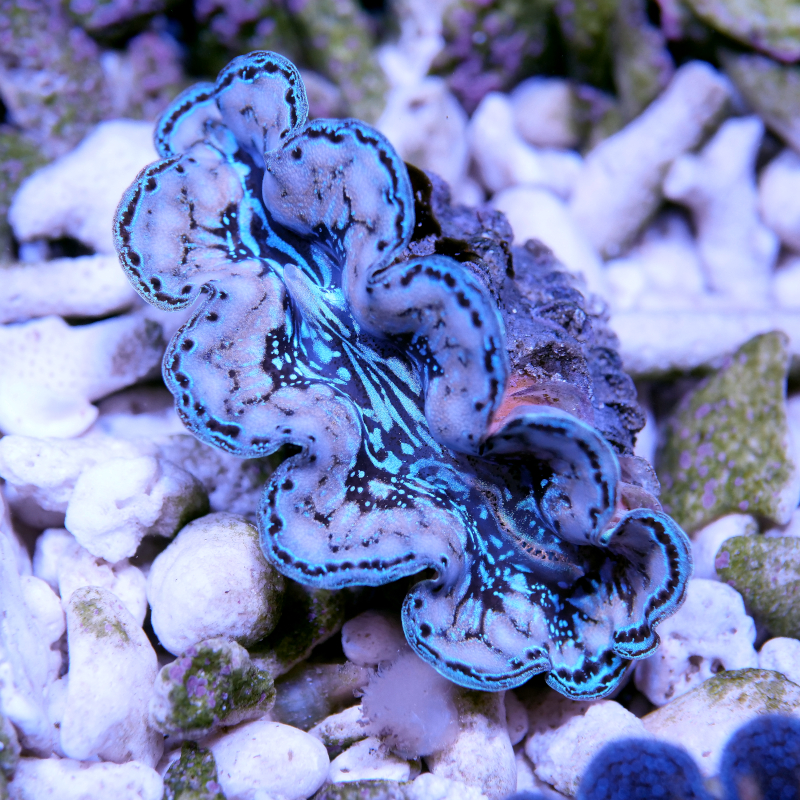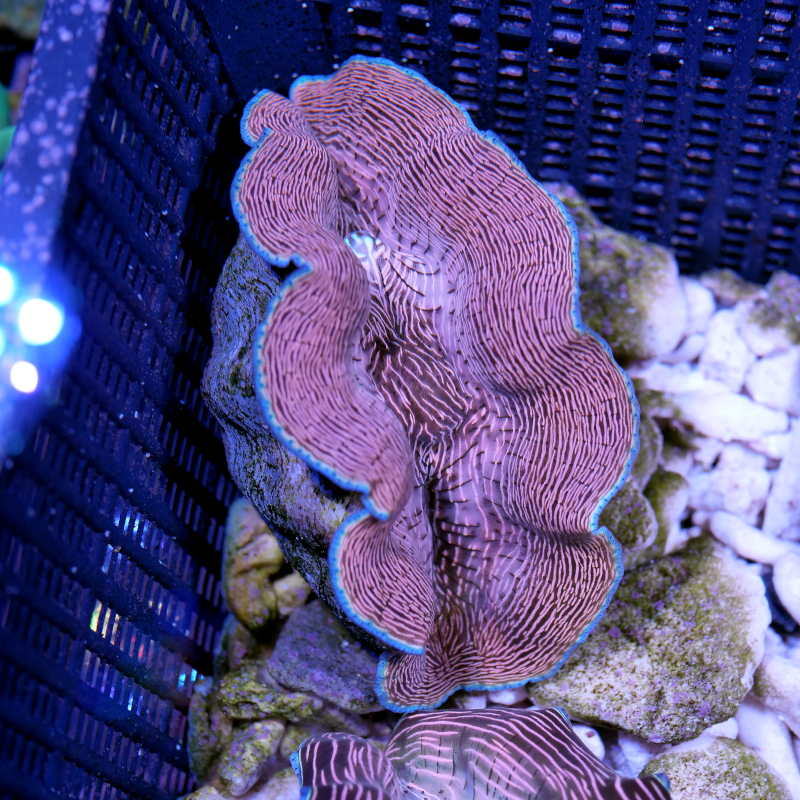Tridacna – how to keep and care for giant clams in reef tanks

Tridacna clams can live to be 30 years and older. To make sure they reach this lifespan in your aquarium, we have a few tips on caring for these beautiful reef inhabitants.
What exactly is it that makes the Tridacna look so incredibly good?
The secret of its beauty are shimmering cells, so called iridophores. These cells are located in the Tridacna's mantle lobe. They contain guanine crystals and reflect incident light. This is giving each shell a unique appearance.
In addition to the iridiophores, there are numerous symbiotic algae in the tissue of the clam. They nourish the Tridacna with metabolic products that are produced during photosynthesis. Giant clams share this property with corals. Both groups of animals are therefore basically quite similar in their requirements for aquarium keeping.
The most important points for keeping Tridacna are lighting and carbonate supply
Place your Tridacna in a well-lit location in the aquarium and avoid shading it from reef structures or corals. Young clams in particular can still be quite mobile and move around with the help of a foot. Therefore, choose a location close to the ground so that the clam cannot fall down and injure itself.
Tridacna occur naturally in the shallow water zone up to 15 m. A spectrum of lighting similar to daylight is therefore the best choice. When lighting with a high propotion of blue, pay more attention to a sufficient supply of nutrients. Limiting nitrates and phosphates while using intensive blue lighting could otherwise unnecessarily stress your clam.
Due to shell growth, clams can consume a considerable amount of calcium and magnesium. A stable supply of calcium (e.g. Balling or All-For-Reef) is therefore essential for the well-being of your Tridacna.
Clam holder for Tridacna – yes or no?
Yes, because the weak spot of a giant clam is on the bottom: the byssal opening. Directly behind this opening is the byssus gland. It produces strong filaments supporting the clam's ability to hold on to substrate. The byssal opening is a typical target of bristle worms. Therefore, never place your Tridacna directly on the substrate or in the sand, but on a clam holder. The size of the byssal opening varies from species to species. It is largest at Tridacna crocea. This species should therefore necessarily be placed on a clam holder.
Removing Tridacna from substrate
Tridacna clams must never be forcefully removed from substrate. Even a supposedly careful twisting out can lead to the byssus gland being damaged or even torn out. Such actions usually lead inevitably to the death of the animals. Should you ever have to remove a clam from anything, the only option is to carefully cut the byssus threads with a sharp scalpel or a razor blade.
Feeding Tridacna – yes or no?
No, because Tridacna clams from about 4 cm shell length do not need to be fed specifically. They obtain their energy almost exclusively from metabolic products of the symbiotic algae. It is therefore important to optimize the conditions for the symbiotic algae. Strong lighting and a few dissolved nutrients in the water - a Tridacna doesn't really need much more than this. An exception are very young and small specimens whose mantle lobes are not yet large enough. These should be fed with very small phytoplankton like Isochrysis. In general be careful with powder food. With small clams this can lead to sticking of internal organs.
Species within the Tridacninae
Tridacninae comprise a total of 12 species divided into the genera Tridacna and Hippopus. Tridacna maxima and T. crocea are the most common species in the aquarium trade thanks to their attractiveness. But also Hippopus hippopus, T. squamosa and T. derasa can be found, although more rarely, in unique color patterns. The species can partly be distinguished from each other by their colors. However, a reliable determination is usually based on the morphology of the shell or mantle characteristics.

Rarely found in the aquarium trade: Tridacna squamosa in blue
Which Tridacna is perfect for me?
The most important criterion when choosing a giant clam for your aquarium is the expected final size. Tridacna crocea with a maximum size of 15 cm is the smallest among the giant clams and generally a good choice for keeping in an aquarium. Tridacna gigas, on the other hand, with an expected final size of 140 cm and a growth rate of 8-12 cm per year, will be an option only for very few aquariums.
|
Species |
expected final size |
|
Tridacna crocea |
15 cm |
|
Tridacna maxima |
25 cm |
|
Tridacna squamosa |
40 cm |
|
Hippopus hippopus |
40 cm |
|
Tridacna derasa |
80 cm |
|
Tridacna gigas |
140 cm |

Tridacna derasa is by far the most demanding giant clam and should only be maintained in very stable water conditions.
Tridacna won´t open – why?
Disturbances by aiptasia, algae or adjacent corals are often a reason why giant clams do not extend their mantle lobe completely. In addition, a location with too strong flow or other reef inhabitants nibbling at the clam can be the reason for an often closed or only half-opened clam. Also an infestation by parasites or a disease cannot be excluded. The cause should be found out in any case and changed or removed, because otherwise the clam can die.
8 typical diseases and parasites of Tridacna and how to fight them
#1 Snails
Especially a representative of the genus Turbonilla from the family Pyramidellidae, commonly known as pyramid snails, can cause problems for Tridacna. The small white snails sit preferably on the upper rim of the shell, under the mantle lobe and suck from the blood lymph of the animal. A low occurrence of these snails is unproblematic. However, if the snail is able to reproduce without restrictions, this can be fatal for a Tridacna in case of heavy infestation.
The best way to get rid of the snails is to search them repeatedly and remove the small pests manually - especially at night. To further ensure that the snails do not multiply, you can add a UV-C filter and increase the skimming. This will remove the planktonic larval stages from the system. Juvenile wrasses of the species Coris gaimard are known as natural predators.
#2 Boring Sponges
Recognizable as a multitude of small, closely adjacent holes filled with sponge tissue, boring sponges can extremely weaken giant clams. As treatment the affected areas should be treated by dabbing them with 1% formalin (outside the aquarium!), then rinsing them with fresh water and finally transferring the animal to a quarantine tank.
#3 Tissue damage from crabs or fish
In general, all algae grazers in a reef tank can become a problem for Tridacna - especially when algae are no longer available. Within the crustaceans these are mainly species from the groups Xanthidae, Portunidae and Dardanus. But also some fish are known to pick at the mantle lobe of the Tridacna. Caution is required especially when socializing with wrasses, Copperband butterflyfish and rabbitfish. Also larger tangs can get an appetite for giant clams if no other algae are available.
As a prevention you should always provide your algae-eating reef inhabitants with sufficient food. As soon as you discover bite marks on the clam, protect it from further attacks. Cover it with a light permeable grid or basket or take the attacker out of the aquarium and give him to a friend of yours.

Clearly recognizable bite marks on a Tridacna crocea. A rabbit fish is suspected. The clams were then covered in baskets with light grid plates. After about 4 weeks the mantle had grown back.
#4 Bleaching
Just like corals, Tridacna can also lose their symbiotic algae, for example, through excessive water temperatures or radiation intensity and become pale. While white corals can compensate for the lack of symbiotic algae by feeding on particulate matter and recover from a short-term bleaching, giant clams usually do not survive a complete bleaching. If you notice that your clam is extremely bright, either place it in a less brightly lit area or reduce the light intensity or duration of illumination.
#5 Bacterial infections
Young clams are especially endangered by this. Bacterial infections manifest themselves through tissue decay. Vibrions or Aeromonas species can be the cause. The best prevention is proper tank hygiene (regular water changes, removal of debris etc.), thoroughly rinsing any frozen food and UV-C filtering.
#6 Protozoan infestation
Actually, only stressed animals are at risk from such an infestation. Symptoms include a wide open inflow opening, incomplete opening of the mantle lobe and whitish spots on the kidneys (not visible externally). Avoid such infections by reducing stress factors: make sure that the animals are transported carefully, keep them at optimal conditions and use the dripping method when acclimating them.
#7 Damages due to low Temperatures
The following applies to Tridacna: short-term hypothermia is more critical than overheating. Water temperatures below 20 °C can already have a negative effect. The animal then withdraws the mantle lobe and hardly reacts to light or touch stimuli. A water temperature between 24 and 26 °C is optimal.
#8 Heavy metal poisoning
Invertebrates such as Tridacna react particularly rapid and sensitive to poisoning by heavy metals. Symptoms are bleaching and a strongly widened inflow opening. Reasons can be corrosive objects (flow pumps, tweezers, blade cleaners ...), contaminated additions (sea salt, drinking water ...) or an overdose of trace elements. It is important here again to identify the cause as quickly as possible and to eliminate it. Besides, a big water change, the use of activated carbon or the addition of Detox of the brand Triton helps.
Summary of the most important facts:
- Gently acclimatize the clam in your aquarium using the dripping method
- Place them on a clam holder
- Ensure strong lighting and stable carbonate
- Never forcibly remove the clam from substrate
- Tridacna crocea and T. maxima are best suited for aquarium keeping
- Additional feeding is not necessary
- Avoid association with potential predators
- Keep activated carbon and a UV-C filter ready in case of emergency